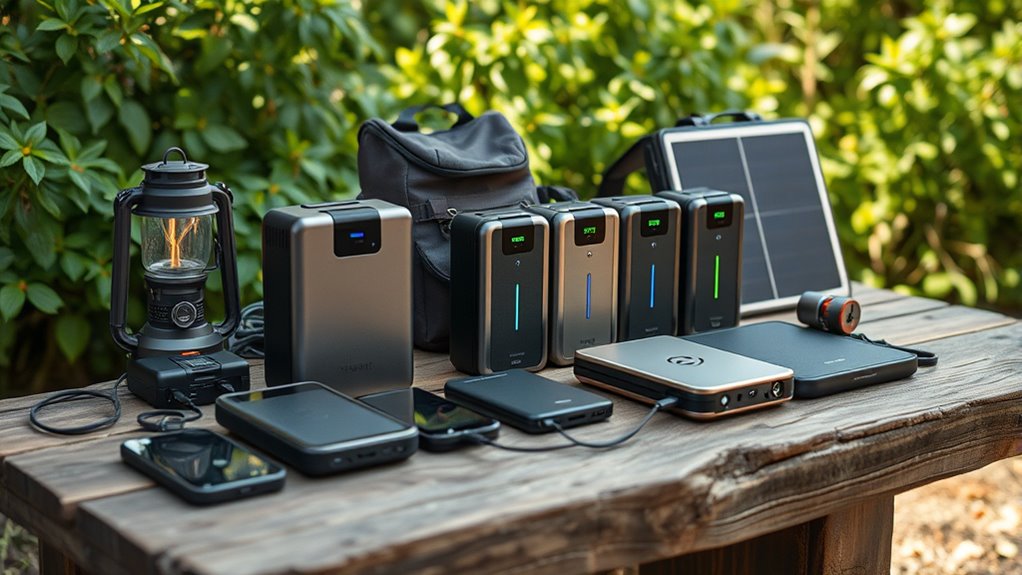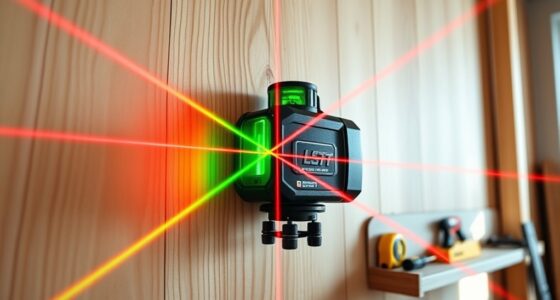If you need reliable power anywhere in 2025, I recommend checking out the top portable stations like the Jackery Explorer 1000 v2, Anker SOLIX models, and the EcoFlow DELTA 2. They offer high capacity, fast recharging, and multiple outlets for all your devices. Compact, lightweight options like the MARBERO 88Wh and smaller models are perfect for travel or emergencies. Keep exploring to find the ideal power station that fits your outdoor and backup needs.
Key Takeaways
- Top models offer high-capacity batteries (up to 1056Wh) and expandable options for versatile outdoor and emergency power.
- Portable designs range from lightweight, backpack-friendly units to more robust options for RV or home backup.
- Fast recharging capabilities (under 1 hour) and solar compatibility ensure efficient, eco-friendly energy replenishment.
- Multiple outlets (AC, USB-C, USB-A, DC) support a wide variety of devices simultaneously in any setting.
- Advanced battery tech like LiFePO4 ensures long-lasting, safe performance for reliable power in any situation.
Jackery Explorer 1000 v2 Portable Power Station

The Jackery Explorer 1000 v2 is an excellent choice for outdoor enthusiasts and emergency preparedness, thanks to its impressive 1,500W continuous power output and 1070Wh LiFePO4 battery. Weighing just 23.8 pounds with a foldable handle, it’s highly portable. It offers multiple outlets, including two USB-C ports, one USB-A, a DC car port, and three pure sine wave AC outlets, supporting fast PD 100W charging. Its smart app control lets you switch modes easily, and the advanced ChargeShield 2.0 guarantees safe, fast recharging. Designed for longevity, it maintains over 70% capacity after 4,000 cycles, making it a reliable, long-lasting power solution.
Best For: outdoor enthusiasts, emergency preparedness, and off-grid living requiring reliable portable power.
Pros:
- High power capacity with 1,500W continuous output and 1070Wh battery for versatile appliance use
- Lightweight and portable at just 23.8 lbs with a foldable handle, ideal for travel and outdoor activities
- Multiple charging options including fast PD 100W USB-C, solar compatibility, and smart app control for convenient operation
Cons:
- Compatible only with Jackery solar panels for solar charging, which may require additional purchase
- Battery capacity, while substantial, may be insufficient for extended power needs without recharging
- The product does not include solar panels, so additional accessories are needed for solar charging
MARBERO Portable Power Station (88Wh) with Solar Charging and AC Outlet

If you’re looking for a portable power station that combines convenience and versatility, the MARBERO 88Wh model is an excellent choice, especially for outdoor enthusiasts and emergency preppers. It charges quickly—up to 80% in just two hours—and supports solar panel input, making it perfect for camping or backyard use. Weighing only 3.2 pounds with a compact design, it easily fits into backpacks or glove compartments. With eight output ports, including USB-C PD and AC outlets, you can power multiple devices like phones, tablets, small appliances, or even your laptop. Its built-in BMS guarantees safety, while the flashlight feature adds emergency utility.
Best For: outdoor enthusiasts, emergency preppers, and travelers seeking a portable, versatile power source for multiple devices and outdoor activities.
Pros:
- Fast charging capability, reaching 80% in just two hours
- Supports solar panel input for eco-friendly outdoor use
- Multiple output ports including USB-C PD and AC outlets for versatile device compatibility
Cons:
- Limited battery capacity of 88Wh may not power larger appliances for extended periods
- Weight of 3.2 pounds, while portable, can still be cumbersome during long hikes or extended travel
- Not suitable for high-power devices exceeding 120W peak or 80W continuous output
Jackery Portable Power Station Explorer 300
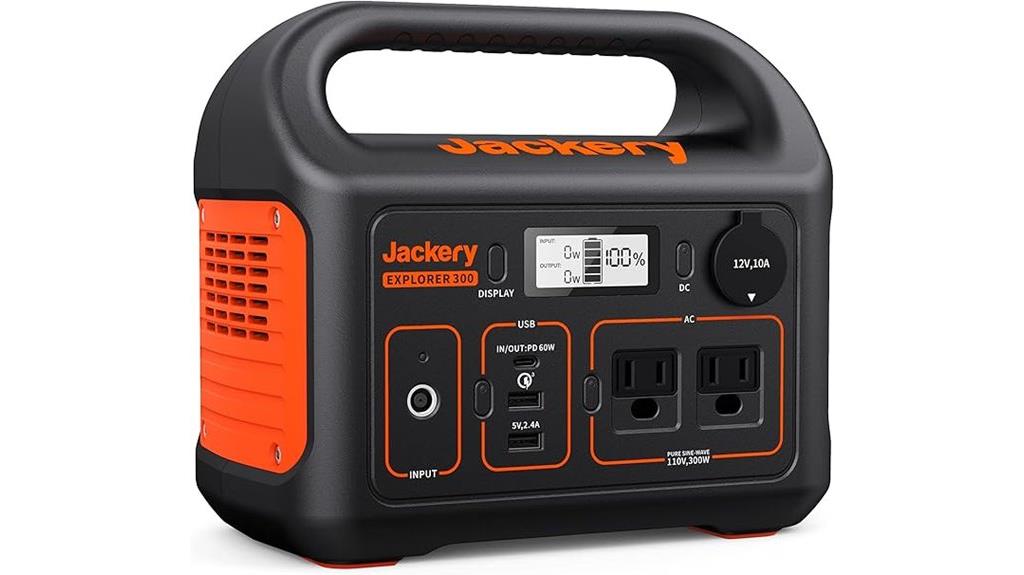
For outdoor enthusiasts and travelers seeking reliable power on the go, the Jackery Explorer 300 stands out with its compact design and solid 293Wh lithium-ion battery. Weighing just 7.1 pounds, it’s easy to carry in a backpack, making it perfect for camping, hunting, or emergencies. It offers two Pure Sine Wave AC outlets, a PD USB-C port, fast charge 3.0, USB-A, and a DC car port, allowing you to power up to six devices simultaneously. It operates quietly and fumes-free, with quick recharging options via wall, car, or solar panels. Its reliable power and portability make it a top choice for off-grid adventures and backup needs.
Best For: outdoor enthusiasts, travelers, and emergency preparedness seekers who need reliable, portable power for multiple devices in off-grid or backup situations.
Pros:
- Compact and lightweight design (7.1 pounds) for easy portability and backpack compatibility.
- Multiple charging options including solar, wall, and car, with fast recharge capabilities.
- Supports powering up to six devices simultaneously with stable 300W pure sine wave AC outlets.
Cons:
- Limited to a maximum of 300W continuous power, which may not suit high-wattage appliances.
- Solar panel sold separately, requiring additional purchase for solar recharging.
- Lithium-ion battery capacity of 293Wh may need frequent recharging during extended use.
Anker Portable Power Station SOLIX C300, 288Wh LiFePO4 Battery
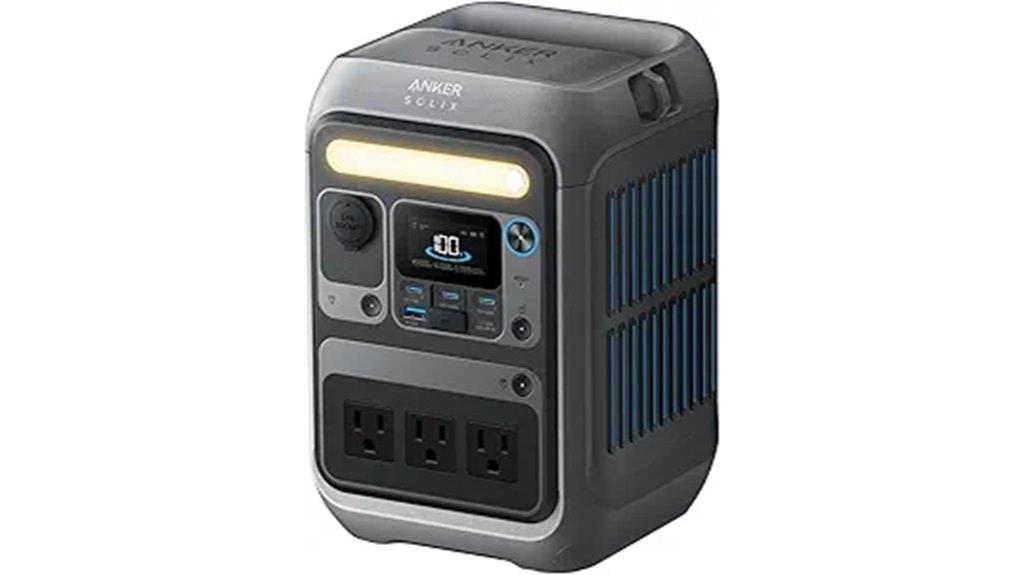
With a compact design weighing just over 9 pounds, the Anker SOLIX C300 is an ideal choice for outdoor enthusiasts and travelers who need reliable power on the go. Its 288Wh LiFePO4 battery offers 300W continuous and 600W surge power, supporting multiple devices via 8 versatile ports, including AC outlets, USB-C, and USB-A. Fast-charging capabilities mean it recharges to 80% in just 50 minutes. Designed for durability with impact resistance and smart temperature control, it’s perfect for camping, emergencies, or travel. Its size is 15% smaller than similar models, and the option to recharge with solar makes it an eco-friendly, dependable power solution.
Best For: outdoor enthusiasts, travelers, and emergency preparedness individuals seeking a portable, durable, and eco-friendly power source for multiple devices on the go.
Pros:
- Compact, lightweight design weighing just over 9 pounds for easy portability.
- Fast-charging capability that recharges to 80% in only 50 minutes.
- Durable construction with impact resistance and smart temperature control for long-lasting use.
Cons:
- Limited to 288Wh capacity, which may not power larger appliances for extended periods.
- Requires a compatible 100W solar panel for solar recharging; not compatible with all panels.
- The strap for portability is sold separately, adding an extra cost for carrying convenience.
Anker SOLIX C1000 Portable Power Station (Optional Solar Panel)

The Anker SOLIX C1000 Portable Power Station stands out for its impressive 1800W rated output and 1056Wh LiFePO4 battery, making it an ideal choice for outdoor enthusiasts and emergency preparedness. It recharges quickly—full in just 58 minutes—thanks to UltraFast technology, and supports solar recharging up to 600W, fully recharging in about 1.8 hours with compatible panels. Weighing only 27.6 pounds, it’s portable yet powerful, with 11 outlets that support nearly all appliances. Its durable LiFePO4 batteries deliver around 3,000 cycles over a decade, ensuring reliable, long-term performance for camping, RV trips, or home backup needs.
Best For: outdoor enthusiasts, campers, RV travelers, and homeowners seeking reliable backup power during outages.
Pros:
- Rapid recharging in just 58 minutes with UltraFast technology.
- Supports solar recharging up to 600W for eco-friendly energy use.
- Lightweight and portable at only 27.6 pounds with versatile outlets supporting nearly all appliances.
Cons:
- Higher initial cost compared to smaller portable power stations.
- Requires compatible solar panels for optimal solar recharging.
- Limited to 1056Wh capacity, which may not power very high-energy devices for extended periods.
EF ECOFLOW Portable Power Station DELTA 2 (1024Wh)
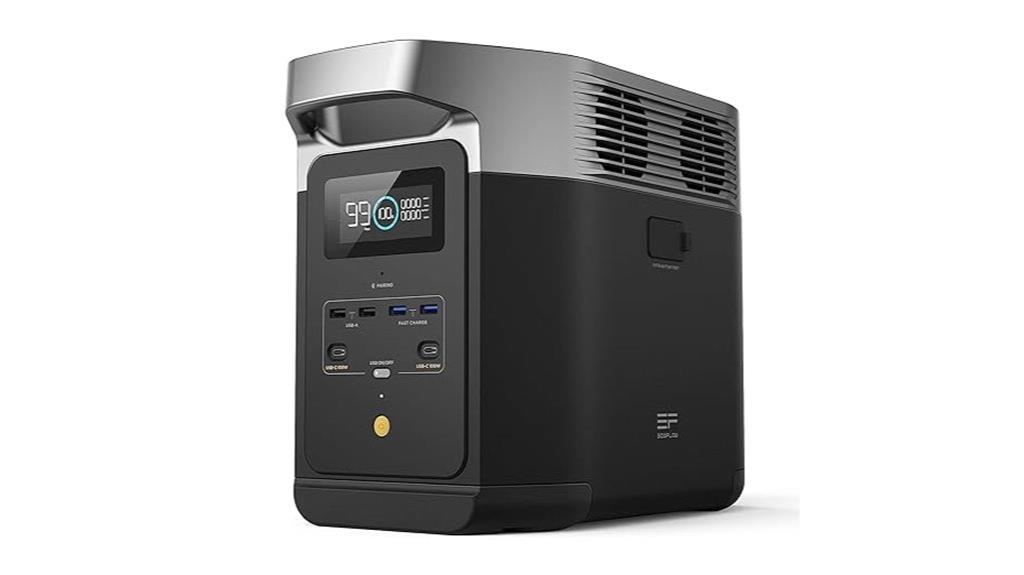
If you’re seeking a reliable portable power station capable of handling demanding energy needs, the EF ECOFLOW DELTA 2 stands out with its impressive 1024Wh LiFePO4 battery that can be expanded up to 3kWh. It offers fast charging—reaching 80% in 50 minutes and full in 80 minutes via AC—and supports solar input up to 500W, perfect for eco-conscious users. With 1800W AC and 100W USB-C outputs, it can power most appliances and multiple devices simultaneously. Built with durable LiFePO4 chemistry and a smart BMS, it guarantees safety and longevity, backed by a 5-year warranty and extensive accessories.
Best For: outdoor enthusiasts, RV travelers, and off-grid living users needing reliable, portable, and expandable power solutions.
Pros:
- High-capacity 1024Wh LiFePO4 battery with expandability up to 3kWh for versatile energy needs
- Fast charging capabilities (80% in 50 minutes) and support for solar input up to 500W
- Multiple outlets (1800W AC and 100W USB-C) allow powering multiple devices simultaneously
Cons:
- Heavier and bulkier compared to smaller portable power banks
- Higher initial cost due to advanced features and expandability
- Limited to 500W solar input, which may slow down charging in low sunlight conditions
Anker 521 Portable Power Station with LiFePO4 Battery (256Wh)

For outdoor enthusiasts and emergency preppers seeking a reliable, long-lasting power source, the Anker 521 Portable Power Station with LiFePO4 battery stands out. It offers a 256Wh capacity, supporting up to 10 years of lifespan thanks to InfiniPower technology. Weighing just 8.2 pounds and measuring roughly 8.5 x 5.67 x 8.33 inches, it’s highly portable and durable. It features 2 AC outlets, USB-A, USB-C PD, and a car socket, supporting multiple devices simultaneously. With surge support up to 600W and solar compatibility, it’s perfect for off-grid adventures or emergencies, providing versatile, long-term power wherever you go.
Best For: outdoor enthusiasts, emergency preppers, and anyone needing reliable, long-lasting portable power for off-grid or backup situations.
Pros:
- Long lifespan of up to 10 years thanks to LiFePO4 battery and InfiniPower technology
- Compact, lightweight design weighing only 8.2 pounds for easy portability
- Supports multiple devices simultaneously with diverse ports including AC, USB-A, USB-C PD, and car outlet
Cons:
- Limited continuous power output of 300W, which may not support high-demand appliances
- Does not include a built-in solar panel, requiring optional purchase for solar charging
- Slightly higher price point due to advanced battery chemistry and long-term durability
Portable Power Station 99.9Wh Power Bank
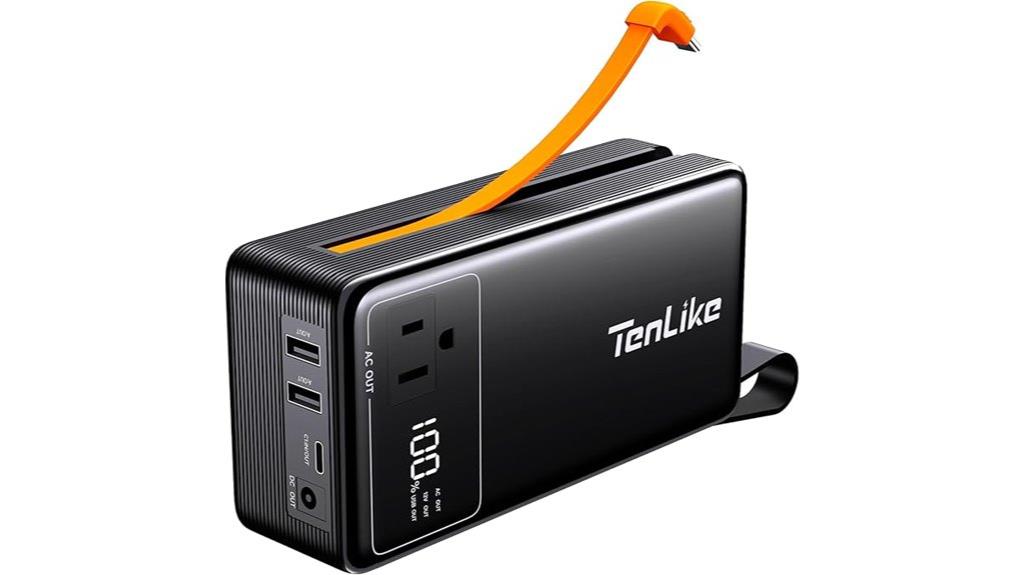
A 99.9Wh portable power bank is an ideal choice for outdoor enthusiasts and travelers who need reliable, compact energy on the go. Its high-capacity lithium battery provides extended power for devices during camping, travel, or emergencies, while remaining airline-friendly. With six versatile ports—including AC, Type-C, USB-C, and DC—it can charge laptops, phones, fans, and small appliances simultaneously. Its compact design, measuring just 6.5 x 3.2 x 1.9 inches and weighing only 1.65 lbs, makes it highly portable. Plus, safety features like a 30-second power-off and E4 alarm guarantee peace of mind, backed by a 2-year warranty for reliability.
Best For: outdoor enthusiasts, travelers, and emergency preparedness individuals who need a compact, reliable power source for multiple devices on the go.
Pros:
- High-capacity 99.9Wh lithium battery suitable for extended device use and airline travel.
- Six versatile output ports, including AC, Type-C, USB-C, and DC, for powering various devices simultaneously.
- Compact and lightweight design (6.5 x 3.2 x 1.9 inches, 1.65 lbs) for portability and space-saving convenience.
Cons:
- Limited maximum AC output of 120W, which may not support larger appliances.
- Only a 2-year warranty, which might be shorter than some users prefer for long-term reliability.
- Recharge speed depends on the input power; may take longer if not charged with a 60W PD charger.
ALLWEI Portable Power Station 300W

The ALLWEI Portable Power Station 300W stands out as an excellent choice for outdoor enthusiasts and emergency preppers alike, thanks to its compact design and versatile charging options. Weighing just 6.5 pounds and measuring 8.86×4.53×8.07 inches, it’s easy to carry on camping, RV trips, or climbs. With a 280Wh capacity and 300W rated power, it can run devices like CPAP machines, drones, phones, and small fridges. It supports multiple charging methods—AC, car, and solar—making it flexible in any situation. Safety features and a silent cooling fan guarantee reliable, quiet operation, giving you peace of mind wherever you go.
Best For: outdoor enthusiasts, emergency preppers, and travelers seeking a portable, reliable power source for essential devices.
Pros:
- Compact and lightweight design (6.5 pounds, 8.86×4.53×8.07 inches) for easy portability
- Supports multiple charging methods including AC, car, and solar, offering versatile power options
- Features safety protections and a silent cooling fan for reliable and quiet operation
Cons:
- Limited to a 300W power output, which may not support high-wattage appliances
- Solar panel sold separately, requiring additional purchase for solar charging
- Run time is dependent on device wattage and may be limited for high-power devices
Portable Power Station 56000mAh with 2 AC Outlets

If you’re searching for a compact yet reliable power source, the Portable Power Station 56000mAh with 2 AC Outlets stands out as an excellent choice. Weighing just 5.73 pounds, it’s smaller than a toaster but packs a 179.2Wh LiFePO4 battery, offering safe, durable power. With 7 ports—including fast-charging USB and Type-C outlets, plus two AC outlets—it can run laptops, lights, fans, and small appliances under 300W. Its peak power is 600W, making it versatile for outdoor adventures, emergency backups, or camping trips. The built-in LED flashlight with SOS mode adds extra safety, ensuring you stay prepared wherever you go.
Best For: outdoor enthusiasts, campers, and emergency preparedness individuals seeking a lightweight, reliable portable power source for small electronics and appliances under 300W.
Pros:
- Compact and lightweight design weighing only 5.73 lbs for easy portability
- Multiple charging options including fast AC, car, and solar inputs for versatile recharging
- Safe LiFePO4 battery with over 3500 charge cycles and built-in safety features
Cons:
- Limited continuous power output of 300W, not suitable for heavy-duty appliances
- Only two AC outlets, which may restrict simultaneous device use
- Price and availability may vary, and it requires careful handling to avoid overloading
Portable Power Station, 266Wh Lithium Battery Backup (300W)

For outdoor enthusiasts and emergency preparedness, the BailiBatt Portable Power Station with 266Wh capacity and 300W peak power stands out as an ideal backup solution. Weighing just 5.9 pounds, it’s highly portable and perfect for camping, RV trips, or home emergencies. It supports fast, safe power delivery to essential devices like laptops, smartphones, and small electronics through its seven versatile ports, including a pure sine wave AC outlet. Its high-capacity lithium-ion battery, combined with built-in safety features like BMS protection, guarantees reliability and durability. Plus, the integrated LED flashlight adds emergency convenience, making it a versatile, compact power source for any situation.
Best For: outdoor enthusiasts, emergency preppers, and anyone needing reliable portable power for camping, RV trips, or home backup.
Pros:
- Compact and lightweight design (5.9 pounds) for easy portability
- Multiple output ports including a pure sine wave AC outlet and fast-charging USB-C ports
- Built-in safety features like BMS protection and LED flashlight for emergencies
Cons:
- Limited total power capacity of 266Wh may not support high-wattage appliances
- Requires periodic recharging every 1-2 months for optimal performance
- Only 1-year warranty, which may be shorter than some competitors
EnginStar Portable Power Station 300W (CPAP Backup Battery)
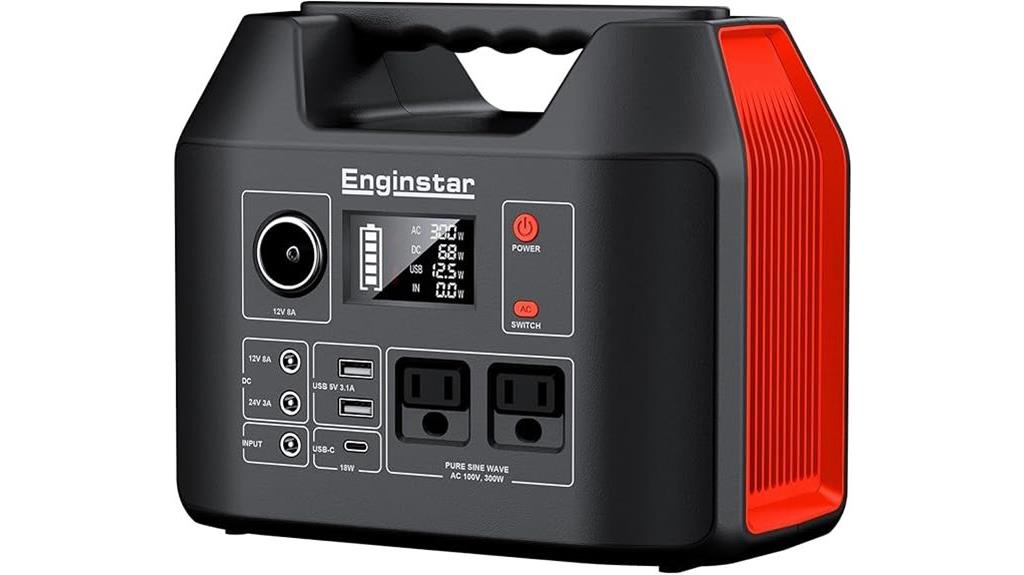
EnginStar’s Portable Power Station 300W stands out as an excellent choice for anyone relying on a CPAP machine during power outages or outdoor adventures. With nearly 300Wh capacity and 300W AC output, it provides reliable, stable power for sensitive devices. Its compact design and lightweight build make it easy to carry anywhere, whether camping or emergency situations. The unit features multiple charging options, including solar, wall outlet, and car socket, ensuring quick recharging. Safety is a priority with advanced protection features, and the digital display keeps me informed about power levels. Overall, it’s a versatile, dependable backup that keeps my CPAP running smoothly wherever I go.
Best For: those seeking a portable, reliable power source to run sensitive devices like CPAP machines during outages or outdoor adventures.
Pros:
- Compact, lightweight design for easy portability
- Multiple charging options including solar, wall outlet, and car socket
- Advanced safety features and digital display for monitoring
Cons:
- Limited 12-month warranty may not cover long-term use
- Capacity might be insufficient for extended power needs beyond basic devices
- The solar charging speed depends on sunlight conditions and panel compatibility
AFERIY P210 Portable Power Station (2400W, 2048Wh) with Solar Charging
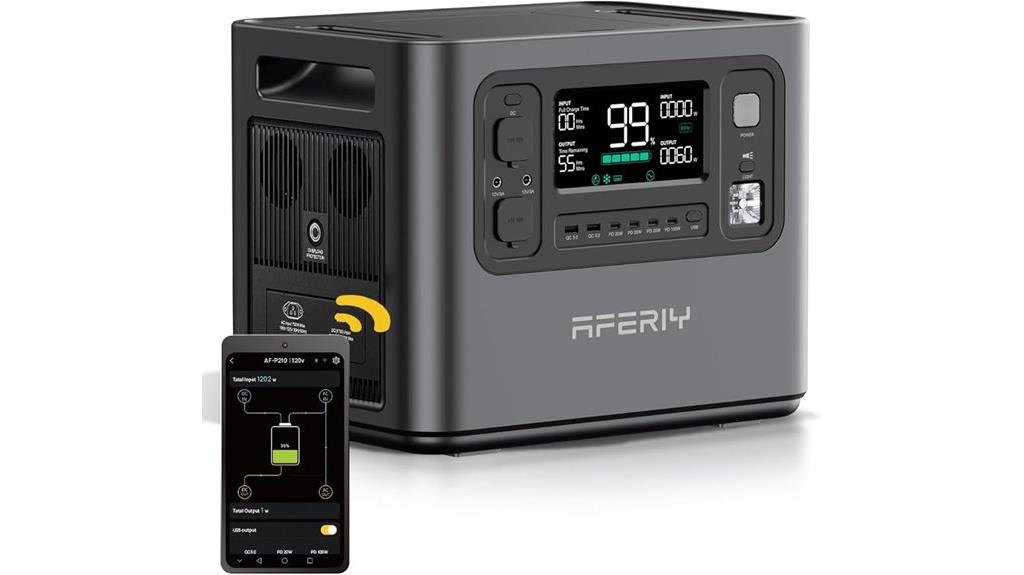
The AFERIY P210 Portable Power Station stands out as an ideal choice for outdoor enthusiasts and emergency preparedness, thanks to its robust 2400W inverter and 2048Wh capacity. Its LiFePO4 battery offers over 3,500 cycles and a 10-year lifespan, while being safer and lighter—20% less weight at 48.5 lbs. With 16 ports, including AC outlets, USB, Type-C, and DC options, it powers a wide range of devices. Its solar charging capability, combined with rapid AC charging and intelligent app management, ensures reliable, silent operation. Plus, its server-level UPS provides seamless backup during outages, making it a versatile, durable energy solution.
Best For: outdoor enthusiasts, emergency preparedness, and anyone needing reliable portable power with versatile charging options.
Pros:
- High-capacity 2048Wh LiFePO4 battery with over 3,500 cycles and 10-year lifespan for long-lasting use.
- Multiple charging options including solar, AC, rapid charging, and intelligent app control for convenience.
- Server-level UPS with <10ms response for seamless backup during power outages.
Cons:
- Relatively heavy at 48.5 lbs, which may affect portability for some users.
- Higher price point compared to smaller or less feature-rich portable power stations.
- Size may be less suitable for very tight or minimalist storage spaces.
OUPES Mega 1 Portable Power Station
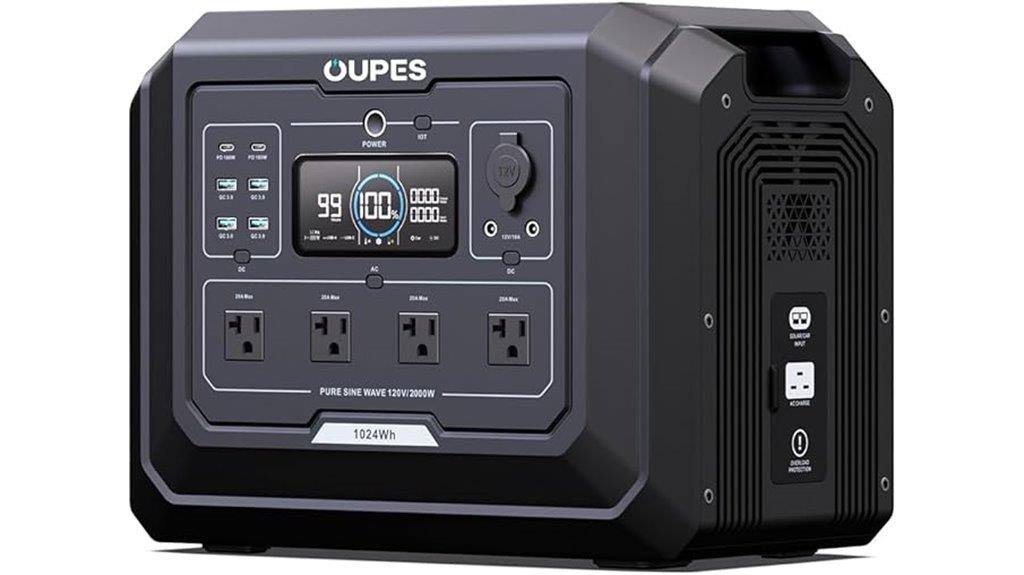
If you’re looking for a versatile and reliable portable power station that can handle high-watt appliances and expand to meet growing energy needs, the OUPES Mega 1 stands out. It features a 1024Wh LiFePO4 battery, expandable to 5120Wh with an extra battery. With 2000W continuous AC output and peaks up to 4500W, it can power refrigerators, CPAPs, and more. It supports multiple charging methods—solar, AC, or car—and includes 13 versatile outlets, fast charging, and smart app control. Weighing just 27.8 pounds, it’s portable enough for camping, emergencies, or off-grid use, offering reliable, expandable power wherever you go.
Best For: outdoor enthusiasts, emergency preparedness, and those needing expandable, high-watt portable power for appliances and electronics.
Pros:
- High capacity and expandability up to 5120Wh for long-lasting power needs
- Powerful 2000W continuous AC output suitable for high-watt appliances
- Multiple charging options including fast solar, AC, and car charging with smart app control
Cons:
- Slightly heavy at 27.8 pounds despite portable design
- WiFi connectivity can be inconsistent, affecting app monitoring
- Battery drain may be faster compared to some competitors like Jackery
Anker SOLIX C300 Portable Power Station (No Wall Charger Included)
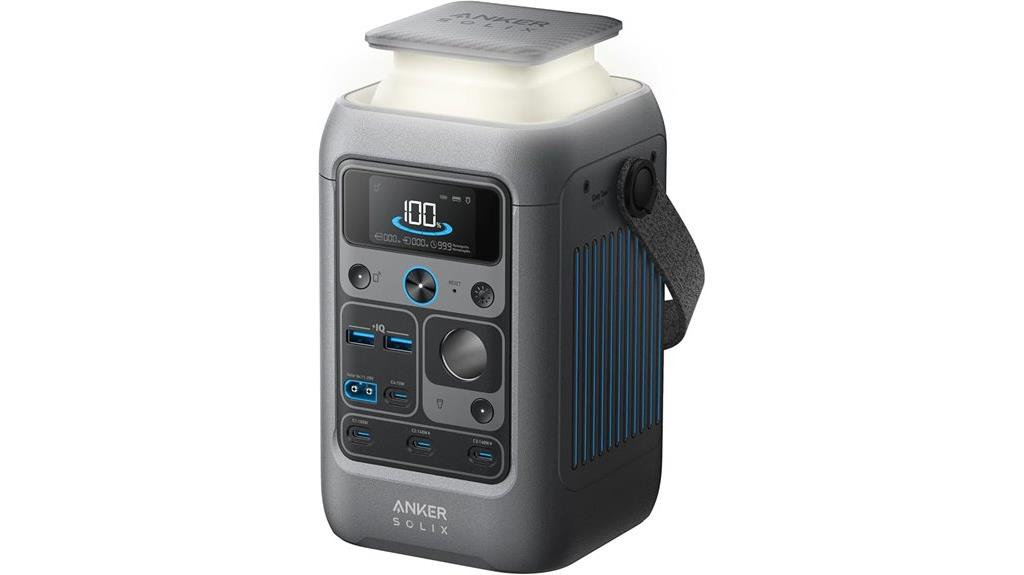
For outdoor enthusiasts and travelers seeking reliable power on the go, the Anker SOLIX C300 Portable Power Station stands out thanks to its compact design and robust features. Weighing just 6.16 pounds, it’s highly portable, measuring 4.89 x 7.87 x 4.72 inches. With a 288Wh capacity, it delivers 300W power, supporting fast charging via two USB-C ports, a car socket, and USB-A ports. It’s built with durable LiFePO4 batteries, offering a 3-year guarantee, smart temperature control, and impact resistance. While it requires an external wall charger for initial setup, it can also be recharged with solar panels or car adapters, making it ideal for outdoor use.
Best For: outdoor adventurers, campers, and travelers who need reliable, portable power without access to traditional electricity sources.
Pros:
- Compact and lightweight design (6.16 pounds, 4.89 x 7.87 x 4.72 inches) for easy portability
- Supports fast charging with dual USB-C ports and multiple device outputs
- Durable LiFePO4 batteries with a 3-year guarantee and impact-resistant construction
Cons:
- Does not include a wall charger; requires an external 18W+ USB-C charger for initial activation
- Limited compatibility with some solar panels, such as Anker SOLIX PS30, PS200, or PS400
- Only supports solar recharging with panels of 60W or higher, which may require additional investment
Factors to Consider When Choosing Portable Power Stations
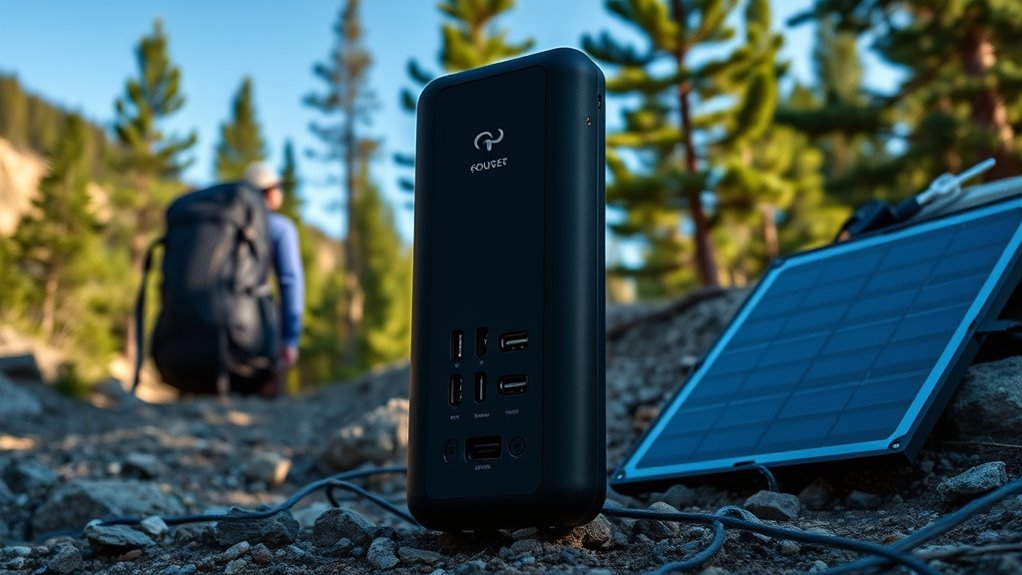
When selecting a portable power station, I focus on factors like power capacity, portability, and available charging options to match my needs. It’s also important to take into account battery life, how many cycles it can handle, and whether it can power my specific devices. By keeping these points in mind, I can choose a station that’s reliable and suits my adventures.
Power Capacity Needs
Choosing the right portable power station depends largely on accurately evaluating your power capacity needs. First, I recommend totaling the wattage of all devices you’ll run simultaneously to ensure the station can handle the load. Don’t forget to account for surge wattage, especially for appliances with motors or compressors, which can spike 2-3 times their regular power draw. Next, match the battery capacity, measured in watt-hours (Wh), to your desired runtime; higher capacity means longer use but usually adds size and weight. Also, think about how long you’ll need power—select a capacity that can sustain your devices without frequent recharging. For emergencies, it’s best to choose a station with a capacity exceeding your maximum needs to ensure reliable backup during extended outages.
Portability and Weight
Selecting the right portable power station involves carefully weighing its weight and size to match your mobility needs. Portable units range from under 2 pounds for compact models to over 50 pounds for heavy-duty options. Lighter models often have smaller batteries, limiting runtime but boosting convenience and ease of transport. Features like ergonomic handles or foldable designs make carrying and storing these units simpler, especially during outdoor adventures or emergencies. Compact dimensions are essential for fitting into backpacks, vehicles, or small storage spaces. The weight-to-capacity ratio is a key consideration—aim for a lightweight station with high capacity to maximize portability without sacrificing power. Ultimately, balancing weight and size ensures you get a portable power solution tailored to your specific activities and mobility requirements.
Charging Options Available
Considering the importance of portability and weight, it’s equally essential to evaluate the charging options available on a portable power station. I look for models that support multiple recharging methods, like AC outlets, car chargers, and solar panels, to stay flexible in any situation. Fast charging is vital; I prefer stations that can reach 80% capacity in under an hour to save time. Compatibility with solar panels, including maximum wattage and connector types, allows eco-friendly recharging off-grid. Fast-charging ports like PD USB-C are a bonus, letting me quickly power devices without delay. Ultimately, I check if the power station can handle multiple devices simultaneously, so I can keep everything running during outdoor trips or emergencies. These features guarantee reliable, versatile charging whenever I need it.
Battery Longevity & Cycles
The lifespan of a portable power station largely depends on its battery’s cycle life, which determines how many times it can be charged and discharged before its capacity drops below 70%. Lithium Iron Phosphate (LiFePO4) batteries often provide over 3,000 to 4,000 cycles, far surpassing traditional lithium-ion options. This higher cycle count means your power station can reliably serve you for many years, often exceeding a decade. Proper battery management, like avoiding full discharges, can further guarantee its lifespan. Some models include advanced Battery Management Systems (BMS) that optimize charge cycles and prevent issues like overcharging, overheating, and deep discharges. When choosing a portable power station, consider these factors to ascertain you get a durable, long-lasting device.
Device Compatibility & Outlets
When choosing a portable power station, making sure it has the right outlets and compatibility for your devices is key. You’ll want to check that it offers the appropriate outlets—AC, USB, USB-C, or DC—to match your devices’ charging ports. Pay attention to the wattage capacity of each outlet to make sure it can handle your electronics’ power needs. If you have sensitive devices like laptops or medical equipment, look for pure sine wave AC outlets, which provide cleaner power. Consider the number of outlets available at once so you can charge multiple devices without swapping cables. In conclusion, verify compatibility with your devices’ charging standards, such as Power Delivery (PD) for fast USB-C charging, and ensure voltage and current ratings align.
Price and Warranty
Price and warranty are two of the most important factors to weigh when selecting a portable power station. Prices can range from under $100 for small units to over $2,000 for high-capacity models with advanced features. While budget options are accessible, investing in a higher-quality unit may offer better durability and performance. A longer warranty, such as five years or more, signals better build quality and provides peace of mind. Many reputable brands offer at least a one-year warranty, with some extending coverage up to ten years on select models. When comparing, consider what the warranty covers—parts, labor, or accidental damage—to ensure you’re protected. Balancing cost with warranty coverage helps you find a reliable power station that offers value and confidence.
Frequently Asked Questions
How Long Do Portable Power Stations Typically Last on a Full Charge?
Portable power stations typically last between 4 to 12 hours on a full charge, depending on how much you’re using them. If you’re powering small devices like phones or LEDs, they can last all day. But if you’re running larger appliances or multiple gadgets, they’ll drain faster. I always check the capacity (measured in watt-hours) to estimate how long they’ll keep my gear running.
Are Portable Power Stations Safe to Use Indoors or in Emergencies?
Sure, portable power stations are generally quite friendly for indoor use and emergencies. I always make sure to follow the manufacturer’s safety guidelines, like avoiding sealed spaces and ensuring proper ventilation. They’re designed with safety features that prevent hazards, so I feel confident using mine during outages or indoors. Just remember to keep them in well-ventilated areas and use them as directed, and they’ll serve you well when you need power most.
Can Portable Power Stations Charge Multiple Devices Simultaneously?
Yes, portable power stations can charge multiple devices at once. I’ve used mine to power my phone, tablet, and even a small cooler all simultaneously. Most models feature multiple outlets, USB ports, and even AC sockets, making it easy to keep everything running without unplugging one device to charge another. Just make certain you don’t exceed the station’s total wattage capacity, and you’ll have no trouble powering multiple devices at once.
What Maintenance Is Required for Portable Power Stations Over Time?
Think of your portable power station as a trusty companion on your adventures; it needs some TLC to stay reliable. I recommend regularly charging it, avoiding completely draining the battery, and keeping it in a cool, dry place. Also, check connections for corrosion and keep vents clear. With a little maintenance, you’ll keep your power source humming like a well-tuned engine, ready whenever you need it.
How Do Environmental Factors Affect Portable Power Station Performance?
Environmental factors considerably impact my portable power station’s performance. Extreme temperatures can reduce battery efficiency and lifespan, so I avoid exposing it to excessive heat or cold. Humidity and moisture can cause corrosion and damage internal components, so I keep mine dry and store it in a cool, ventilated place. Also, dust and dirt can clog vents, so I regularly clean it. Proper care ensures reliable power when I need it most.
Conclusion
As you explore these power options, think of each as a trusted companion ready to light your path through any adventure. Whether it’s a gentle sunrise or a wild night under the stars, these stations quietly guarantee your devices stay alive and your journey continues smoothly. With the right choice, you’ll have a steady heartbeat of energy, allowing you to embrace every moment fully—no matter where life takes you.
